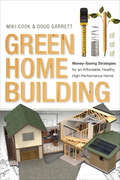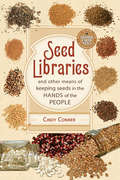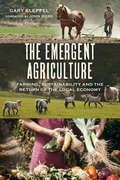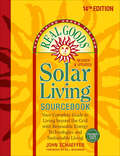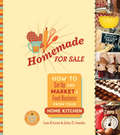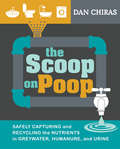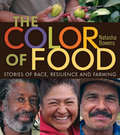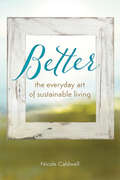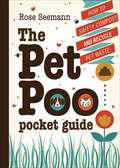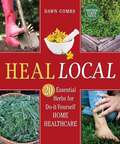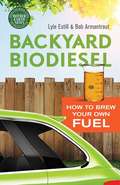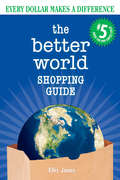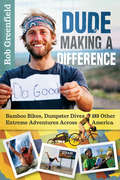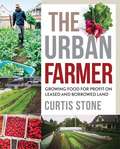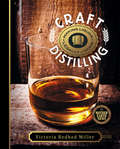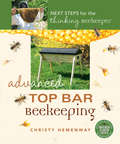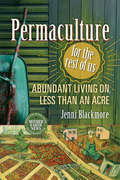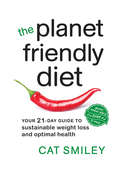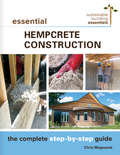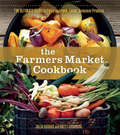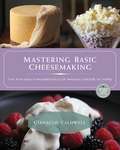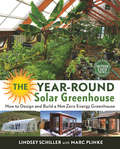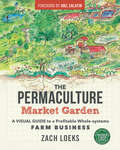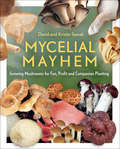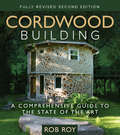- Table View
- List View
Green Home Building: Money-Saving Strategies for an Affordable, Healthy, High-Performance Home
by Doug Garrett Miki CookAccording to conventional wisdom, building a green home is an expensive endeavor. The standard approach treats green as an add-on, tacking "premium" products, finishes, and equipment onto a traditional home design. As a result, many green home projects end up over budget or fail to achieve their environmental and performance goals.Green Home Building explodes the myth that green homes have to cost more. Using proven methods based on applied building science, the authors show how to: Lower base construction costs to provide funding for high performance upgrades Achieve a net-zero energy home, including "zero-ing" water, waste, carbon, and associated costs within fifteen years Live affordably into the future, despite anticipated rising costs for fuel, water, materials, taxes, and health careThis comprehensive guide to building green on any budget defines the strategies that maximize the return on green investments. Written for anyone who has ever been swayed by the argument that the price tag limits how green a home can be, Green Home Building is a must-read for builders, contractors, architects, designers, and homeowners.Miki Cook is a green building and sustainability consultant who has dedicated her career to educating contractors and the public on the strategies, methods, and benefits of green homes.Doug Garrett has trained thousands of homebuilders, architects, and sub-contractors to build energy-efficient homes using applied building science to improve comfort, durability, and healthfulness while meeting or exceeding the energy code.
Seed Libraries: And Other Means of Keeping Seeds in the Hands of the People
by Cindy ConnerHistorically, seed companies were generally small, often family-run businesses. Because they were regionally based, they could focus on varieties well-suited to the local environment. <P><P>A Pacific Northwest company, for example, would specialize in different cultivars than a company based in the Southeast. However the absorption of these small, independent seed businesses into large multinationals, combined with the advancement of biotechnology resulting in hybrids and GMO seeds, has led to a serious loss of genetic diversity. The public is now at the mercy of the corporations that control the seeds.In the past few years, gardeners have realized the inherent danger in this situation. A growing movement is striving to preserve and expand our stock of heritage and heirloom varieties through seed saving and sharing opportunities. Seed Libraries is a practical guide to saving seeds through community programs, including: Step-by-step instructions for setting up a seed library A wealth of ideas to help attract patrons and keep the momentum going Profiles of existing libraries and other types of seed saving partnershipsWhoever controls the seeds controls the food supply. By empowering communities to preserve and protect the genetic diversity of their harvest, Seed Libraries is the first step towards reclaiming our self-reliance while enhancing food security and ensuring that the future of food is healthy, vibrant, tasty, and nutritious.Cindy Conner is a permaculture educator, founder of Homeplace Earth and producer of two popular instructional gardening DVDs. She is also the author of Grow a Sustainable Diet.
The Emergent Agriculture
by Gary Kleppel John IkerdLong embraced by corporations who are driven only by the desire for profit, industrial agriculture wastes precious resources and spews millions of tons of greenhouse gases into the atmosphere each year, exacerbating climate change and threatening the very earth and water on which we depend. However, this dominant system, from which Americans obtain most of their food, is being slowly supplanted by a new paradigm.The Emergent Agriculture is a collection of fourteen thematic essays on sustainability viewed through the lens of farming. Arguing that industrial food production is incompatible with the realities of nature, science, and ethics, this lyrical narrative makes the case for a locally based food system which is: Stable in the face of economic uncertainty Resilient in the face of environmental variability Grounded in stewardship of the land, on attaching value to food and the craft involved in producing it, and on respecting the dignity of farmers, consumer,s and livestockA revolution in food production is underway. Written from the vantage point of an ecologist who is also a farmer, The Emergent Agriculture is essential reading for anyone interested in food security and the potential for growing local economies. Food for thought about the future of food.Gary Kleppel is a professor of biology at the SUNY Albany, where he focuses on sustainable agriculture, conservation-based grazing, and the ecology of human-dominated landscapes. He and his wife Pam are owners of Longfield Farm, where they produce grass-fed lamb, wool, free range chickens and eggs, and artisanal breads.
Real Goods Solar Living Sourcebook (Mother Earth News Books for Wiser Living)
by John SchaefferWhat book would you want if you were stranded on a desert island? Widely regarded as the "bible" of off-grid living, Real Goods Solar Living Source Book might be your best choice. With over six hundred thousand copies in print worldwide, it is the most comprehensive resource available for anyone interested in lessening their environmental footprint or increasing their energy independence.The Solar Living Sourcebook, Fourteenth Edition is the ultimate guide to renewable energy, sustainable living, natural and green building, off-grid living, and alternative transportation, written by experts with decades of experience and a passion for sharing their knowledge. This fully revised and updated edition includes brand new sections on permaculture and urban homesteading and completely rewritten chapters on solar technology, sustainable transportation, and relocalization. It also boasts greatly expanded material on: Natural building Permaculture and biodynamics Electric and biofuel-powered vehicles Passive solar Solar water heating Grid-tie photovoltaic systems--plus maps, wiring diagrams, formulae, charts, electrical code, solar sizing worksheets, and much more.Whether you're a layperson or a professional, novice or longtime aficionado, the Sourcebook puts the latest research and information at your fingertips--everything you need to know to make sustainable living a reality.John Schaeffer is the president and founder of Real Goods--the foremost global source for tools and information on renewable energy, energy efficiency, and sustainable living. Since 1978, through Real Goods, he has pioneered solar technology in North America, providing over one hundred and fifty megawatts of solar power and helping to solarize over eighteen thousand homes.
Homemade for Sale: How to Set Up and Market a Food Business from Your Home Kitchen (Mother Earth News Books for Wiser Living)
by John D. Ivanko Lisa KiviristFrom farm-to-fork and "Buy Local" to slow food and hand-made artisan breads, more people than ever are demanding real food made with real ingredients by real people. Widely known as "cottage food legislation," over forty-two states and many Canadian provinces have enacted recent legislation that encourages home cooks to create and sell a variety of "non-hazardous" food items, often defined as those that are high-acid, like pickles, or low moisture, like breads or cookies. Finally, "homemade" and "fresh from the oven" on the package can mean exactly what it says.Homemade for Sale is the first authoritative guide to conceiving and launching your own home-based food start-up. Packed with profiles of successful cottage food entrepreneurs, this comprehensive and accessible resource covers everything you need to get cooking for your customers, creating items that by their very nature are specialized and unique. Topics covered include: Product development and testing Marketing and developing your niche Structuring your business and planning for the future Managing liability, risk, and government regulationsYou can join a growing movement of entrepreneurs starting small food businesses from their home. No capital needed, just good recipes, enthusiasm, and commitment, plus enough know-how to turn fresh ingredients into sought-after treats for your local community. Everything required is probably already in your home kitchen. Best of all, you can start tomorrow! Lisa Kivirist and John D. Ivanko are co-authors of Farmstead Chef, ECOpreneuring, and Rural Renaissance, and are innkeepers of the award-winning Inn Serendipity Bed & Breakfast (innserendipity.com).
The Scoop on Poop
by Dan ChirasFlush it and forget it is the plumbing mantra of the industrialized world. Most people just want sewage to go away, preferably without having to see, smell, or worse yet, touch it. But crap has a bad rap. Human waste is a valuable resource we can use to support food production. Blackwater, greywater, and solids are actually rich in organic matter, and alternative means of handling these "wastes" can conserve enormous quantities of fresh water for other uses.The Scoop on Poop presents a wide range of ways to answer the call of nature, and in so doing to maximize the benefits of existing waste water. This book explores proven alternatives to Western sanitation. Whether you're interested in composting toilets, outdoor grey- or blackwater planters, constructed wetlands, or other innovative solutions, author Dan Chiras will walk you through: System pros and cons Design, construction, and maintenance advice Costs, permitting issues, and the safe treatment of composted wasteAll system plans are relatively simple and straightforward enough for the average homeowner to build and install. Intended for readers who live in cities, towns and rural environments, this is a practical guide to safe, ingenious ways to capture the nutrients from waste and recycle them back into your soil to grow fruit trees, vegetables, and flowers--all without running afoul of the "ick" factor. Dan Chiras is the author of over thirty books on residential renewable energy and green building, and is the director of the Evergreen Institute's Center for Renewable Energy and Green Building.
The Color of Food: Stories of Race, Resilience and Farming
by Natasha BowensImagine the typical American farmer. Many people visualize sun-roughened skin, faded overalls, and calloused hands--hands that are usually white. While there's no doubt the growing trend of organic farming and homesteading is changing how the farmer is portrayed in mainstream media, farmers of color are still largely left out of the picture.The Color of Food seeks to rectify this. By recognizing the critical issues that lie at the intersection of race and food, this stunning collection of portraits and stories challenges the status quo of agrarian identity. Author, photographer, and biracial farmer Natasha Bowens's quest to explore her own roots in the soil leads her to unearth a larger story, weaving together the seemingly forgotten history of agriculture for people of color, the issues they face today, and the culture and resilience they bring to food and farming.The Color of Food teaches us that the food and farm movement is about more than buying local and protecting our soil. It is about preserving culture and community, digging deeply into the places we've overlooked, and honoring those who have come before us. Blending storytelling, photography, oral history, and unique insight, these pages remind us that true food sovereignty means a place at the table for everyone.Natasha Bowens is an author, farmer, and creator of the multimedia project The Color of Food. Her advocacy focuses on food sovereignty and social issues.
Better
by Nicole CaldwellIntellectual arguments alone will not sway the dominant paradigm; to be motivated to create change, people must be moved. Art has the power to inform, influence, and inspire. The creative impulse can, quite literally, change the world.Better explores the intersection of sustainability and art, showing how each of us can reinvent our lives as our greatest artistic achievement. Presented in the context of the unique story of Better Farm, a blueprint for environmentally conscious living originally established as an intentional community, this unusual guide blends theory with practical, hands-on, DIY ideas to incite your own creative adventures, including: Upcycling trash into treasure Turning your fish tank into a garden Making your yard or balcony a work of artBetter is a concrete application of the Better Theory, which views every experience--good or bad--as an opportunity for exponential personal growth. Packed with life lessons and tips for making any lifestyle more sustainable, while drawing on everyone's inherent creativity, this unique book provides the inspiration to live more simply, take more chances, and engage more with the natural world. A must-read for anyone who questions the purpose of the daily grind or grapples with the need for more meaning in his or her life.Nicole Caldwell is the co-founder of Better Farm, a sixty-five-acre sustainability campus, organic farm, and artists' colony serving as a blueprint for environmentally conscious living. Her writings have been featured in Mother Earth News, Reader's Digest, and Time Out New York, among others.
The Pet Poo Pocket Guide: How to Safely Compost and Recycle Pet Waste
by Rose SeemannEighty-three million dogs and ninety-six million cats call the United States home. Dogs alone produce enough waste to fill more than 1,091 football fields 1 foot deep in a single year. Add billions of plastic pick-up bags to the mix and season well with tons of litter box waste. Scoop a hefty portion into local landfills and seal it tightly to ensure optimal methane production. Clearly, this is a recipe for disaster.Dog and cat owners who trash their pets' offerings daily are in denial about how much waste is produced and what happens to it. Those who want to make the responsible choice often turn to the internet, only to find misleading, confusing, and contradictory information. The Pet Poo Pocket Guide will help you reduce your pet's environmental paw print with: Best practices for cycling pet waste back to nature Suggestions on how to tailor your approach based on location, situation, weather, needs, or available time Instructions for using your composted pet waste safely to enrich your soil and nourish ornamental plantsWith recycling tactics clearly indicated as "easy," "moderate," or "demanding," The Pet Poo Pocket Guide offers something for everyone. This no-nonsense guide is a must-read for any pet owner who is concerned about the environmental impact of their best friend, and is seeking a safe and practical solution.Rose Seemann is the owner and operator of EnviroWagg, a company dedicated to collecting and composting canine waste into safe, nutrient-rich garden soil.
Heal Local: 20 Essential Herbs for Do-it-Yourself Home Healthcare (Mother Earth News Books for Wiser Living)
by Dawn CombsMost of us understand the value of eating and buying local. Taking back our food, goods, and services from multinational corporations and sourcing them from small growers, producers, artisans, and entrepreneurs benefits our families, our environment, and our communities. Heal Local argues that "100-mile healthcare" can be equally valuable in terms of how we treat illness and injury and maintain wellness.This innovative guide demonstrates that by harnessing multifaceted whole plants, we can rely on homegrown or regionally produced herbs rather than importing exotics and non-natives. Based on the small apothecary model, author Dawn Combs explains how to: *Maximize the benefits of homegrown first aid, from increased freshness, potency, and effectiveness to community resilience and local economic growth *Make home herbal healthcare less intimidating and more attainable, by focusing on twenty herbs to effectively treat most common injuries and ailments*Implement a local medicine culture safely and sustainably, while protecting and respecting wild plant populationsMany herbals overwhelm their readers, presenting a list of hundreds of herbs, each with a different purpose. Heal Local empowers readers by showing that you don't need to know everything about every herb on the planet to create a complete home apothecary. Anyone can be self-sufficient with their wellness, regardless of their previous knowledge, experience, or available space.Dawn Combs is a homestead herbalist with over twenty years' experience and author of Conceiving Healthy Babies. As well as training others in herbal home healthcare, she treats her family's common illnesses and minor injuries with natural therapies, herbal remedies, and appropriate foods.
Backyard Biodiesel
by Lyle Estill Bob ArmantroutSmall-scale home biodiesel production holds a singular attraction for the do-it-yourself enthusiast. While perhaps it can't save the world, this unique renewable fuel is economical, fun to make, better for the environment, and will help you reduce your dependence on Big Oil. And getting started is easier than you think.Backyard Biodiesel is written by two recognized experts in the field of small-scale biofuels. This comprehensive hands-on, practical, DIY guide includes: The basics of small-scale brewing--recipes, strategies, and technologies Advanced backyard analytics and troubleshooting Safety considerations and regulatory issues Topping up the tank--how to put your biodiesel to work for youMaking your own fuel is not only possible, it is rewarding. Designed to be accessible to everyone from readers with no prior technical expertise to alternative energy buffs, Backyard Biodiesel is a must-read for any aspiring brewer, packed with everything you need to get up and running quickly and safely.Lyle Estill is the president and co-founder of Piedmont Biofuels and the author of Industrial Evolution, Small is Possible, and Small Stories, Big Changes. He has won numerous awards for his commitment to sustainability, outreach, community development, and leadership.Bob Armantrout helped to manage four commercial biodiesel plants before joining Piedmont Biofuels in 2007. He works as an instructor at Central Carolina Community College, where he spearheads an innovative two-year biofuels degree program.
The Better World Shopping Guide #5
by Ellis JonesWhile we generally try to make our vote count every four years, few of us realize that our most immediate power to shape the world is being squandered on a daily basis. Every dollar we spend has the potential to create social and environmental change. In fact, it already has. The world that exists today is in large part a result of how our purchasing decisions have shaped it.The Better World Shopping Guide rates hundreds of products and services from A to F so you can quickly tell the "good guys" from the "bad guys" and ensure your money is not supporting corporations who make their decisions based solely on the bottom line. Drawing on decades of meticulous research, this completely revised and updated fifth edition will help you find out who actually "walks the talk" when it comes to: Environmental sustainability Human rights Community involvement Animal protection Social justiceSmall enough to fit in a back pocket or handbag, and organized in a user-friendly format, The Better World Shopping Guide will help you reward the companies who are doing good, penalize those involved in destructive activities, and change the world as you shop!Ellis Jones, PhD, is the award-winning, best-selling author of four previous editions of The Better World Shopping Guide and co-author of The Better World Handbook. A scholar of social responsibility, global citizenship, and everyday activism, Jones has dedicated himself to uncovering practical ways for people to make a difference in the world. He currently teaches at Holy Cross College.
Dude Making a Difference
by Rob GreenfieldYou want to do something for the planet, but what? Change a light bulb, install a low-flow faucet, eat organic? How about ride forty-seven hundred miles across America on a bamboo bicycle, using only water from natural sources, avoiding fossil fuels almost completely, supplying your few electrical needs with solar power, and creating nearly zero waste?Sound crazy? Maybe. But not if you're Rob Greenfield. Then it sounds like a pretty amazing way to bring your message to as many people as possible, and to have a great time doing it. Dude Making a Difference is Rob's first-person account of his incredible adventure in radical sustainability. Join him as he pedals from coast to coast in three and a half months while: Creating only 2 pounds of trash Using just 160 gallons of water Eating 284 pounds of food from grocery store dumpstersThis one-of-a-kind travelogue will inspire you to reexamine your relationship with the earth's resources. Rob's captivating stories of life on the low-impact road are rounded out by practical guides to help you reduce your personal ecological footprint and plan your own larger-than-life adventures. Author's proceeds from the sale of Dude Making a Difference will be donated to 1% for the Planet. Rob Greenfield is an adventurer and environmental activist whose creative campaigns educate and inspire. He's crossed the US twice on a bamboo bicycle, gone a year without showering, and dived into over one thousand dumpsters, all to wake people up to the impact of their daily actions and to instigate social change.
The Urban Farmer
by Curtis Allen StoneThere are twenty million acres of lawns in North America. In their current form, these unproductive expanses of grass represent a significant financial and environmental cost. However, viewed through a different lens, they can also be seen as a tremendous source of opportunity. Access to land is a major barrier for many people who want to enter the agricultural sector, and urban and suburban yards have huge potential for would-be farmers wanting to become part of this growing movement.The Urban Farmer is a comprehensive, hands-on, practical manual to help you learn the techniques and business strategies you need to make a good living growing high-yield, high-value crops right in your own backyard (or someone else's). Major benefits include: Low capital investment and overhead costs Reduced need for expensive infrastructure Easy access to marketsGrowing food in the city means that fresh crops may travel only a few blocks from field to table, making this innovative approach the next logical step in the local food movement. Based on a scalable, easily reproduced business model, The Urban Farmer is your complete guide to minimizing risk and maximizing profit by using intensive production in small leased or borrowed spaces.Curtis Stone is the owner/operator of Green City Acres, a commercial urban farm growing vegetables for farmers markets, restaurants, and retail outlets. During his slower months, Curtis works as a public speaker, teacher, and consultant, sharing his story to inspire a new generation of farmers.
Craft Distilling
by Victoria Redhed MillerMany people have experienced great success making their own beer or wine at home. In recent years a number of hobbyists have become interested in making distilled spirits. However, distilled spirits are more complicated to produce, and the process presents unique safety issues. In addition, alcohol distillation without a license is illegal in most countries, including the United States and Canada. From mashing and fermenting to building a small column still, Craft Distilling is a complete guide to creating high-quality whiskey, rum and more at home. Experienced brewer, distiller, and self- reliance expert Victoria Redhed Miller shares a wealth of invaluable information including: Quality Spirits 101: Step-by-step recipes and techniques Legal Liquor: An overview of the licensing process in the United States and Canada Raising the Bar: Advocacy for fair regulations for hobby distillersThis unique resource will show you everything you need to know to get started crafting top-quality spirits on a small scale - and do it legally. Sure to appeal to hobbyists, homesteaders, self-sufficiency enthusiasts, and anyone who cares about fine food and drink, Craft Distilling is the ideal offering for independent spirits. Victoria Redhed Miller is a writer, photographer and homesteader who lives on a forty-acre off-grid farm in northwest Washington State with her husband David. She strives to enhance her family's self-reliance through solar energy, gardening, food preservation, raising heritage poultry, blacksmithing, and other traditional skills Victoria is the author of Pure Poultry: Living Well with Heritage Chickens, Turkeys and Ducks.
Advanced Top Bar Beekeeping: Next Steps for the Thinking Beekeeper (Mother Earth News Books for Wiser Living)
by Christy HemenwayBee populations are plummeting worldwide. Colony Collapse Disorder poses a serious threat to many plants which rely on bees for pollination, including a significant proportion of our food crops. Top bar hives are based on the concept of understanding and working with bees' natural systems, enabling top bar beekeepers to produce honey and natural wax while helping bees thrive now and in the years ahead.Advanced Top Bar Beekeeping picks up where The Thinking Beekeeper left off, providing a wealth of information for backyard beekeepers ready to take the next step with this economical, bee-friendly approach. Author Christy Hemenway shares: Guidance and techniques for the second season and beyond An in-depth analysis of the dangers climate change and conventional agriculture present to pollinators An inspiring vision of restoring bee populations through organic farming and natural, chemical-free beekeeping.While continuing to emphasize the intimate connection between our food system, bees, and the wellbeing of the planet, Advanced Top Bar Beekeeping breaks new ground in the quest to shift the dominant agricultural paradigm away from chemical-laden, industrial monoculture and towards healthy, diverse local farming. See what all the buzz is about with this must-read guide for the new breed of thinking beekeeper.Christy Hemenway is the owner and founder of Gold Star Honeybees, a complete resource for all things related to beekeeping in top bar hives. A passionate bee-vangelist and advocate for natural, chemical-free beekeeping, Christy is the author of The Thinking Beekeeper: A Guide to Natural Beekeeping in Top Bar Hives.
Permaculture for the Rest of Us
by Jenni BlackmoreMany of us want to increase our self-sufficiency, but few have access to the ideal five sunny, gently sloping acres of rich, loamy, well-drained soil. Jenni Blackmore presents a highly entertaining, personal account of how permaculture can be practiced in adverse conditions, allowing anyone to learn to live more sustainably in a less-than-perfect world. With a rallying cry of "If we can do it, you can too," she distills the wisdom of twenty years of trial and error into a valuable teaching tool.The perfect antidote to dense, high-level technical manuals, Permaculture for the Rest of Us presents the fundamental principles of this sometimes confusing concept in a humorous, reader-friendly way. Each chapter focuses on a specific method or technique, interspersing straightforward explanations with the author's own experiences. Learn how to successfully retrofit even the smallest homestead using skills such as: No-till vs. till gardening, composting, and soil-building Natural pest control and integrating small livestock Basic greenhouse construction Harvesting, preservation, and moreIdeal for urban dreamers, suburbanites and country-dwellers alike, this inspirational and instructional "encouragement manual" is packed with vibrant photographs documenting the author's journey from adversity to abundance. Jenni Blackmore is a farmer, artist, writer and certified Permaculture Design Consultant who built her house on a rocky, windswept island off the coast of Nova Scotia almost twenty-five years ago and has been stumbling along the road to self-sufficient living ever since. A successful micro-farmer, she produces most of her family's meat, eggs, fruit, and vegetables, in spite of often-challenging conditions.
The Planet Friendly Diet
by Cat SmileyWould you like to lose weight, feel great, and minimize the impact of your eating habits on the environment? The Planet Friendly Diet is a unique, all-inclusive blueprint for a greener lifestyle based on responsible dietary choices. Jump start your journey to optimum health with the all-inclusive twenty-one day meal plan, and then apply the information in the accompanying nutrition guide to transform short-term success into long-term, sustainable results.Leading body-transformation expert and former professional skier Cat Smiley shares her simple step-by-step program for a complete detox and reboot. The diet is meat, dairy, wheat and gluten-free, and comes with a weekly shopping list to ensure zero-waste. All single-portion recipes: Use fresh, every day ingredients Cost less than $5.00 Are under 500 calories Take no more than twenty minutes to prepareWhether you want to give your eating patterns a complete makeover or just kick start a change towards a healthier life, The Planet Friendly Diet will motivate, educate and empower you. Fully-illustrated with mouthwatering images of each internationally inspired recipe, it's like having your very own nutrition coach and personal chef. And not only will yopu lose weight, get fit, and feel great - you'll be contributing to a wider humanitarian cause. Cat Smiley is an award-winning body transformation specialist and owner of Canada's premiere weight-loss retreat for women, Whistler Fitness Vacations. A former world-class skier, she is a philanthropist, nutritionist, and master trainer.
Essential Hempcrete Construction: The Complete Step-by-Step Guide
by Chris MagwoodHempcrete is a versatile, energy-efficient natural insulation material, useful for walls, roofs, and floors. Made from the inner stem of the hemp plant mixed with a lime-based binder, it is a very strong, lightweight and breathable alternative to manufactured insulations. Essential Hempcrete Construction is a fully-illustrated practical guide to this affordable, renewable method, from procurement to finishing.This indispensable manual is packed with all the information you need to determine whether hempcrete is the right choice for your project. It covers: Material specifications, testing and building code references and climate data Detail drawings for design reference Tool lists, and complete step-by-step instructions for mixing and placing hempcrete Finishing and maintenance techniques Budgeting and labor estimates Additional resourcesEssential Hempcrete Construction is part of New Society's Sustainable Building Essentials Series. Written by the world's leading sustainable builders, designers and engineers, these succinct, user-friendly handbooks are indispensable tools for any project where accurate and reliable information are key to success. Get the Essentials!Chris Magwood is a sustainable builder and designer specializing in green and natural building techniques, the co-founder and co-director of the Endeavour Centre, and the author of several books on sustainable building including Making Better Buildings, More Straw Bale Building, and Straw Bale Details.
The Farmers Market Cookbook: The Ultimate Guide to Enjoying Fresh, Local, Seasonal Produce
by Julia Shanks Brett GrohsgalFarmers' Markets and CSAs are among the best places to find high-quality, diverse, and exciting vegetables and fruits. But the rich array of unusual varieties can be confusing and overwhelming. From detailed produce descriptions to storage tips, preparation techniques, and over two hundred flavorful recipes, The Farmers' Market Cookbook has the answer to every prospective locavore's perennial question, "What do I do with this?"Featuring a range of traditional favorites alongside innovative creations showcasing the stunning flavors of heirloom fruits and vegetables, this guide to seasonal eating will help you engage your powers of creativity, learning, and experimentation. Recipes include: Garlic scape vichyssoise Potato fennel "risotto" Beef roulade with cilantro mojo Cantaloupe salsaEating locally cultivates appreciation for those who grow our food. Full of practical insights from field to fork, The Farmers' Market Cookbook celebrates the small farmer's labor of love with recipes that showcase every crop at its best--essential reading for anyone who wants to appreciate fresh food at its best.Julia Shanks has honed her culinary talents working in restaurants around the country, developing a taste for fresh, local and seasonal foods. She consults with restaurants, farms and food producers, helping them maximize profits and streamline revenues through sustainable business practices. Brett Grohsgal worked as everything from line cook to executive chef while developing and sharing his appreciation for artisanal, seasonal foods. Now he runs Even' Star Organic Farm, growing and harvesting crops year-round for restaurants, grocery stores, universities, farmers markets, and the farm's own successful CSA.
Mastering Basic Cheesemaking: The Fun and Fundamentals of Making Cheese at Home (Mother Earth News Books for Wiser Living)
by Gianaclis CaldwellThe craft of home cheesemaking is exploding in popularity. However, most "beginner" books are essentially loosely organized collections of recipes which lack a progressive approach to teaching the fundamentals of this exciting and satisfying traditional skill. <P><P>Mastering Basic Cheesemaking provides a complete hands-on guide to making cheese and other fermented dairy products from scratch, geared toward helping the novice cheesemaker to develop the intuition and abilities to position them for success, especially in the real world of the home kitchen.
The Year-Round Solar Greenhouse: How to Design and Build a Net-Zero Energy Greenhouse
by Lindsey Schiller Marc PlinkeComprehensive coverage of passive solar greenhouse design including material selection, building methods and how to store thermal energy using a variety of simple and innovative strategies. Over a dozen case studies provide real-life inspiration, capped off with how-to guidance for building a durable, energy-efficient greenhouse. Variations include underground and aquaponic greenhouses and integrating solar panels to grow off-grid, year-round.
The Permaculture Market Garden: A Visual Guide to a Profitable Whole-systems Farm Business
by Zach LoeksAuthor Zach Loeks brings together his passion for sustainable permaculture food production systems and beautiful, vibrant illustrations to provide a highly visual guide to the smooth integration of permaculture into the market garden, without use of major equipment or operation changes. Profiling crops and ecosystem-based systems, Loeks demonstrates a profitable, sustainable and approachable model for the future of market gardening.
Mycelial Mayhem: Growing Mushrooms for Fun, Profit and Companion Planting
by Kristin Sewak David SewakMost supermarket mushrooms are bland and boring; products of an industrial process which typically relies on expensive equipment and harmful pesticides. Many people would like to add more flavorful and diverse fungi to their diets, but lack the knowledge or confidence to gather or grow their own. Do-it-yourself cultivation is a fun, exciting way to incorporate a variety of mushrooms into a sustainable lifestyle. Mycelial Mayhem is a straightforward, no-nonsense resource for the aspiring mushroom grower. This practical guide cuts through much of the confusion surrounding methods and techniques, helping the hobbyist or farmer to: Select regionally appropriate species for the home garden, farm-scale production, or an edible landscape Practice sustainable, environmentally friendly cultivation techniques, such as companion planting, to combat common garden pests and diseases Choose a successful, proven business approach to maximize profit and minimize frustration Many people find that DIY mushroom cultivation is not nearly as complicated as they expect, but a knowledgeable and experienced mentor is crucial to success. Whether your goal is to harvest homegrown gourmet mushrooms for your table, supplement your income by selling to friends and neighbors, or start a full-fledged niche business, Mycelial Mayhem is packed with the advice and resources you need to succeed with this rewarding and valuable crop. David Sewak and Kristin Sewak are avid growers of edible mushrooms, heirloom vegetables, native landscape plants and sustainable landscape design. They speak on mushroom gathering and indoor and outdoor cultivation techniques at regional and national green living events.
Cordwood Building: A Comprehensive Guide to the State of the Art
by Rob RoyCordwood masonry walls are low-cost, easy to build, aesthetically pleasing, and score high environmental points for making use of low-impact materials. This fully revised second edition of the most widely read and used book on cordwood construction presents the latest innovations and on-the-ground experience from four decades of cordwood building and research. New chapters cover the practical how-to and the full depth and breadth of cordwood construction, including load-bearing and non-load-bearing walls, integrating electrical wiring, innovations on corner designs, new mortar options such as lime putty, and the latest on cob-cordwood, insulation options, and bottle-end designs. There is detailed treatment of code compliance, efficient house shapes, and design considerations. Richly illustrated and augmented with fresh case studies ranging from Hawaii and the Adirondacks to Tasmania and Michigan, Cordwood Building remains the most comprehensive book available on cordwood masonry construction methods. Rob Roy has been building, researching and teaching about cordwood masonry for four decades. Widely recognized as a world leading authority on cordwood construction, Rob started Earthwood Building School in 1981 to train builders in the latest cordwood building methods. He has authored and edited a dozen books on alternative and natural building including the first edition of Cordwood Building, Timber Framing for the Rest of Us, Earth-Sheltered Houses, and Stoneview. Rob has also presented four videos, including two about cordwood, and has taught cordwood masonry all over the world.
